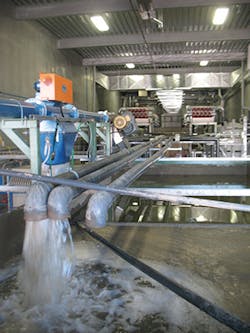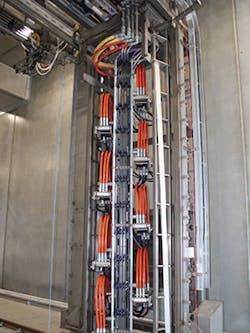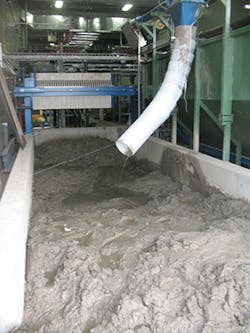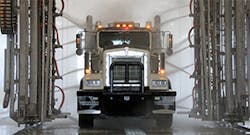A tractor trailer is more than just a large piece of on-road equipment. It’s a major investment, foundation to a livelihood, and a home away from home. Collectively, big rigs are the engine that keep industries and economies in motion.
But none of that comes cheap. A new truck and trailer can cost well over a $250,000, and that’s not including a lot of chrome and aftermarket equipment so often added to personalize vehicles. After all, plenty of truckers find ways to make their million-mile rolling office as comfortable as possible.
The miles are a given, so long as the truck is properly maintained, and clean. The challenge of removing snow, ice, mud, and salt gave rise to the modern, roadside truck wash.
Washing big rigs—from over-the-highway trucks to off-road energy industry trucks—is infinitely more involved than washing cars. They’re bigger, sure, but they also come in a wide variety of sizes and shapes.
The side of the gantry features both high-pressure spray heads and low-pressure spray heads.
WATER, THE LIFEBLOOD OF EVERYTHING
“Whether you’re washing an oil field truck covered in 5,000 pounds of mud or you’re cleaning a chromed-out road truck, water is a huge consideration,” says Jyrki Koro, president of Truck Wash Technologies Inc., in Sault Ste. Marie, Ontario. “It takes a lot of water, and itneeds to be processed accordingly.”
With 21 years in the truck wash industry, Koro started the company in 1999, with a vision to develop the commercial, for-profit truck wash that has eluded other manufacturers to date. Designing superior automation and water treatment technology that can adapt to a very diverse trucking industry was key, but equally important is minimizing capital costs related to building and land, and developing a service and operational standard which allows the business model to work.
“Until recently, little has changed in the truck wash industry in the past 40 years or so,” says Koro. “We aim to provide a fast and affordable public wash that offers value and consistency while delivering what every owner wants: a clean and shiny truck.”
Their innovative wash system provides an automated cleaning rivaled only by a long, labor-intensive manual wash, but utilizing advanced technology that delivers high wash quality with minimal labor costs.
Conditioned fresh water is used during the portion of the wash when cleaning chemicals are used, and also during the final, spot-free rinse. For all other facets of the washing process, large amounts of recycled water are used.
“During the design of our truck wash systems, we researched the trucking industry to determine the needs of the end user and tailored a system using innovative designs and vendors to complement the application with quality components,” says Koro. Though he’s been designing truck wash systems for 16 years, the current model has been seven years in the making.
“The one key supplier we kept coming back to in the design phase was Watts. The company not only offered multiple systems that we needed, but they make equipment that can handle the volume of water we need,” added Koro. The fresh water portion of the system includes filtration, scale prevention, and reverse osmosis (RO) for uncompromising purity.
Solids are discharged into a sludge bunker to be removed for disposal.
TWO TYPES OF FRESH WATER
As fresh water comes into the facility from a well or municipal supplies, it’s treated for scale prevention either by template-assisted crystallization (TAC) technology or traditional water softener with brine tank. Using both technologies provides a more cost-effective approach to treating all incoming water to a degree that suits its application in the wash process.
If used for high-pressure rinsing applications, water first goes through a 100-gallon-per-minute Watts OneFlow anti-scale system to treat water before entering a large storage tank for use. This chemical-free TAC anti-scale technology bonds calcium ions together so that they’re inert, and won’t build up on surfaces downstream. It’s used chiefly to reduce the negative effects of water hardness (calcium carbonate) in plumbing systems, appliances, valves, and other components.
After TAC treatment, water is used in the high-pressure, fresh water rinsing of the vehicle. For fresh water used during the chemical application process, a different anti-scale approach is used.
“Because calcium and magnesium rapidly absorb the cleaning chemicals and render them less effective, we need to be absolutely sure that all minerals are removed from the water stream for chemical application. TAC reduces scale buildup, but the ions are still in the water. So, a commercial Watts water softener conditions the water used in the chemical application. This amounts to roughly 30 gallons per truck wash.”
Fresh water supplied to the softener passes first through a large Watts carbon filter that features automatic backwashing. The activated carbon media in the large tank is generally used for dechlorination, removal of tastes and odors, and as pretreatment for reverse osmosis systems. Chlorine causes destruction of reverse osmosis membranes and polymer based ion exchange resins used in water softeners.
A spot-free, final rinse is the very last phase of a truck wash. For this, water is treated by a large reverse osmosis system. A 4,400 gallon-per-day (GPD) reverse osmosis system provides ample water volume. The RO removes any remnant of minerals that could otherwise create powdery looking spots on the vehicle surface after drying.
Watts offers this Deluxe Commercial RO system in three sizes for this application, from 2,200–6,600 GPD. This all-in-one package includes everything from a standalone frame and pre-filter to centrifugal pump and monitoring equipment. It’s recommended for greenhouses, car washes, and as feed-water treatment for large boiler systems.
SEDIMENT REMOVAL
The freshwater purification components of the truck wash system ensure minimal chemical costs and production of a clean truck with no streaks or spotting. Nonetheless, recycled water does the heavy lifting.
Each Truck Wash Technologies system uses recycled water for the bulk of the washing process. Heavily soiled trucks can require as much as 12,000 gallons of recycled water, but never less than 2,000.
“We have off-road trucks come in with so much mud that it actually reduces the amount of cargo they can legally haul,” says Koro. “Needless to say, this cuts into their paycheck.”
As the system’s moving gantry makes pass after pass over the vehicle, tons of sediment drains into an in-floor catchment system. A series of screens and settlement tanks strain solids from the liquid.
A cluster of high-volume hydro cyclones manufactured by Bailey-Parks Urethane provides a second level of water filtration, spinning fine dirt out of the stream in a centrifuge. Finally, a liquid polymer is injected into the water. This substance binds any remaining finesolids together so that they settle out more quickly. All sediment is continuously removed from the wash water and dewatered for ease of disposal.
ON DOWN THE ROADA Truck Wash Technologies installation will service upwards of 1,000 trucks each month. As drivers wait 15 or 20 minutes for their rig to come out sparkling clean, they’re often unaware of the multitude of high-tech processes going on in the background.




